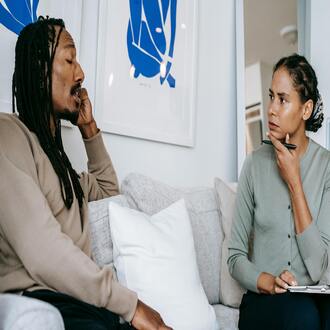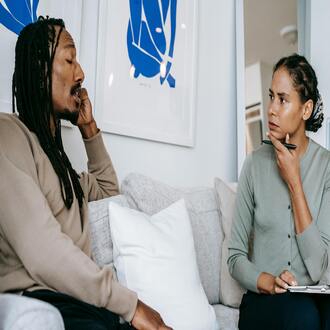Transcription Nutritional coaching process
What is a coaching process?
According to the International Coaching Association (ICF), coaching consists of working together with the client in a creative and stimulating process, which serves as inspiration to maximize their personal and professional potential.
It is an ongoing relationship between coach and coachee, where they work on the objectives of the latter. This process is divided into sessions, usually lasting an hour and a half each. The sessions progress in stages, where the context is defined, the current and ideal situation, the feedback stage, the definition of the action plan and the follow-up of the actions that are carried out.
Advice in which one person (coach) will try to help and advise another (coachee) in the complicated task of knowing where we are going, what we want to achieve and what means will be used.
The four main steps of a coaching process
- How the coaching process works. In the first contact it is good to explain to the client what this process consists of, which is nothing more than accompanying him/her in a new vital journey that he/she is about to undertake. It is also important to define the objective, assessing how important it is for the coachee.
- Broaden perspective. The coachee is encouraged to explore options that he/she has not considered before. Through open-ended questions, they are encouraged to analyze as many possibilities as they can think of. In each session it is the coachee who decides the topic to be discussed in relation to his or her objective. It is a work of awareness, where you learn things about yourself that gives you a boost of security to achieve your goal, while it can be a very powerful discovery for personal growth.
- Breaking mental barriers and self-sabotage. In his book "Man's Search for Meaning", Viktor Frankl, concluded that between what happens to us and how we react to it there is a space of personal freedom where we can decide how to live and interpret that experience. Through coaching tools it is possible to change that mental framework that can be a limiting factor and turn it into beliefs that empower the coachee and give him/her enough confidence to achieve his/her goals. These goals can be of a personal nature (feel comfortable with their image, finish a university degree, etc.). Or professional in nature (Effectively lead a team, enhance company results, among others).
- Create an action plan and act. There is no change without action, therefore, during the coaching process it is established what actions the coachee will take for the next session, what are the steps to move towards success, whatever this term means for the coachee.
Benefits of a coaching process
It allows to define precisely the objectives and where to focus the efforts to achieve them It offers another vision on the subject, questioning and analyzing beliefs, habits and unproductive behaviors. It is an opportunity to explore alternatives that were not handled before and can bring new possibilities in the achievement of goals. It reinforces conversational skills, team management and leadership.
Characteristics of the coaching process that differentiate it from other disciplines.
Tailored, future-oriented approach, with a pre-determined duration. Based on relationships that establish openness, trust and collaboration, where the coach provides the coachee with certain, timely and clear feedback that serves to establish objectives and goals.
The agenda is set by the coachee, who decides which aspects to improve or change in order to be more effective. Accept that the coachee has the resources (or can acquire them) to achieve his or her goals. Rather than giving advice, the coach's role is to ask questions that broaden the coachee's thinking horizons.
Its purpose is for the coachee to fully develop his or her potential to achieve goals. Seeks to achieve goals, providing a learning environment.
Individual or team coaching processes
Individual coaching processes: Generally they are sessions of approximately one hour and a half of duration, the number of sessions is agreed based on the objectives to be addressed.
Team coaching processes: must be tailored to the people who are going to be part of it, personalized and adapted to their needs, so there is no rule that dictates how to do it because each case must be studied specifically.
Several authors basically agree on the stages of these processes, both individual and team.
Stages of the individual coaching process
Establish the coaching relationship: In the first meeting the client's needs for this process are addressed, the objectives to be achieved are specified, as well as the possible obstacles that may appear. The degree of motivation of the client must be known and he/she must be made aware that the process will imply personal changes that must be assumed voluntarily. It is necessary to create a climate of trust and summarize the situation in a report, an agreement is drawn up where the type of coaching to be performed, the rules that will govern the process and the objectives to be achieved are set out.
Action planning: The results of the initial report are analyzed and coaching begins in areas with room for improvement, trying to make the client aware of his weaknesses and strengths. Objectives are specified and clarified, which are challenging, measurable and time-bound, in order to establish an action plan.
Some questions that can help are:
- How important is each objective to me?
- What will I do to address it?
- When will I do it?
- What strategies do I need to accomplish the plan?
- How will I demonstrate that I have achieved my goals?
The coach should recommend that the client share the results with his or her environment, which increases his or her commitment.
The coaching cycle: It consists of starting to work in the field, with real situations, the coachee discovers his potential and the tools that are provided. As progress is made, progress is reviewed and any obstacles or difficulties that may arise are addressed. The client is provided with knowledge and techniques to develop his or her capacity for improvement while observing his or her evolution. At this stage, the coach also gives feedback highlighting the positive aspects and those that can be improved. This phase lasts until the client is able to perform tasks, even developing them unconsciously and automatically.
This is the moment to evaluate if the sessions are working, for example:
- Progress from one session to another.
- Ease in communicating successes and failures.
- Proactivity in proposing solutions.
- Level of enthusiasm and attention to the sessions.
Evaluation and follow-up: Provides the opportunity for the coach to obtain a summary of the results after the coaching intervention, measuring achievements and developing strategies to ensure progress. They bring a sense of gradual closure to the relationship. Sometimes these sessions can be extended until the content is internalized.
Some of the key questions that can help to carry out the follow-up are:
- What confidence does the coachee have in the follow-up plan?
- What might get in the way of follow-up?
- What will be the most difficult to do?
- How will the coachee know that difficulties have arisen?
- What resources does he/she have available for these difficult periods?
- How will he/she remember what has been learned?
Stages of the team coaching process
Initial planning: To concretize the objectives to be achieved, the path to follow is designed. A context must be achieved in which all those involved understand what is to be achieved. This process must be based on confidentiality and trust in the coach and other members of the group.
Personal objectives: It is necessary that all members, in addition to the goals to be achieved as a group, have clear personal objectives. It is valid to hold personal sessions where points of view an
process coaching




